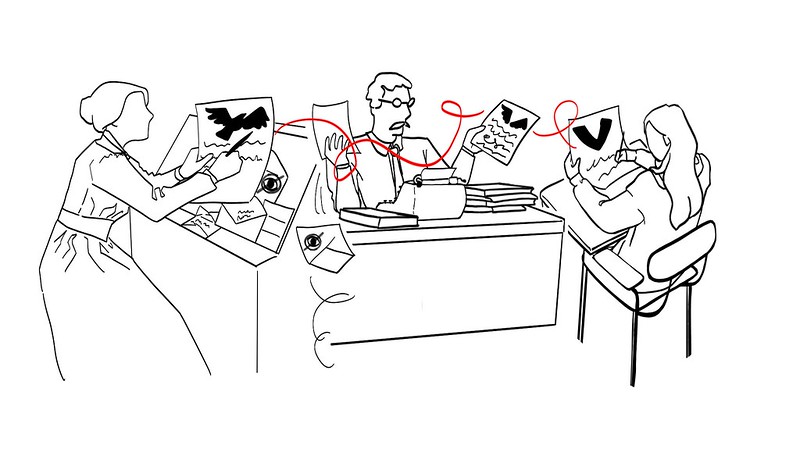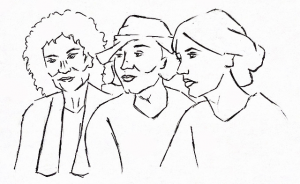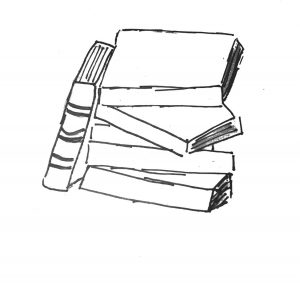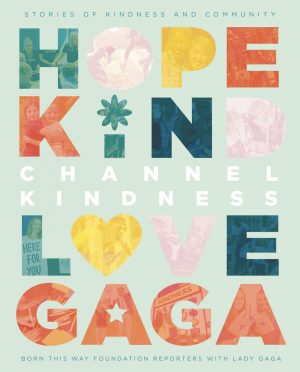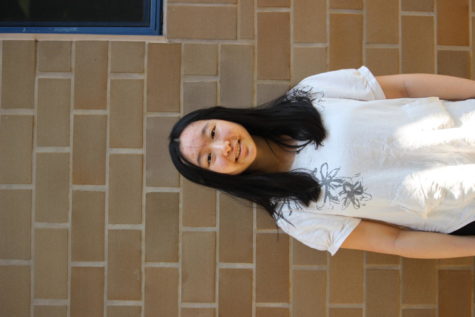Non-consensual publication must weigh the author’s will over artistic value.
Author intent is subject to change between stages of the publication process.
June 12, 2022
On the first day of junior year, my (Sylvia) AP Literature teacher broadcasted a poem by Emily Dickinson on the classroom projector and asked for volunteers to read it to the class. I was one of them. After spending the period analyzing the poem, our teacher tossed in a fun little factoid for us — “Oh, by the way, Dickinson didn’t want her poems to be read.”
It is not as though we were disrespectful while discussing the poem. On the contrary, the response was overwhelmingly positive. But after putting the poetry under a fine lens and picking it apart bit by bit, suddenly being told the author didn’t want it to be seen at all felt like a gross violation. There is a bond formed between a reader and a poem when the piece of work resonates with a reader’s feelings. Dickinson’s works have endured so long for that very reason. But the bond I felt, and I’m sure many of my classmates felt, after learning that Dickinson hadn’t wanted her poem published turned acrid.
I admit I was willing to go to bat for her immediately with very little clue of what I was doing. I remember frantically messaging my classmates as we considered the possibility of starting a movement to boycott Dickinson in class — I loved her poetry, but if she didn’t want it read, then damned if I ever read it again.
This opinion piece has been floating around in my head ever since that first day of junior year. I’ve never been able to gather the words to write it out, because I didn’t think I even knew what exactly it was that gave me that visceral feeling of being a trespasser. But as a senior, fully over my year of AP Literature, I think I can finally find what I want to say. Dickinson — and any author whose circumstances surrounding publication are unclear — should not be taught unless students ask for it to be (due to informed interest in the respective author or writing). If they are, a lesson should be dedicated to addressing the authors’ wishes and a discussion should be opened on how to proceed with the lesson.
For many writers like Emily Dickinson and Franz Kafka, their writing comes from a place of intimacy; it is personal. There is a vulnerability that readers can empathize with.
“You open a vein and bleed all over the page in your [personal] writing [to say what] you don’t have license to say out loud in normal conversation,” Freshman English teacher Noah Kopp explained.
But, for writers like Emily Dickinson, Franz Kafka and Harper Lee, their personal writing was revealed to the public eye unfairly. Their privacy was ripped apart from them and their raw emotions were openly displayed for strangers to judge.
Each of their experiences reveal different avenues through which writing was published without the writer’s permission.
Emily Dickinson
Dickinson is a staple of most high school English classes. But the author never expressed clear consent to be published; poems published during her lifetime may have been so without her knowledge. She is recorded to have “considered” publishing her novels, but only when pressured into doing so in charity for aid to children. After her death, Dickinson’s sister decided her poems should be published, enlisting other poets to edit her work, contrary to Dickinson’s final request.
Despite claims of Dickinson’s position on publishing being unclear, she showed her opinion through her actions: i.e. not publishing her writing during her lifetime. The only time Dickinson wavered was when she was guilted into doing so. After her death, Dickinson’s poems were slightly edited and published despite having no instructions to do so.
Harper Lee
“To Kill a Mockingbird” is considered a classic novel dealing with prejudice and race, but Harper Lee’s second novel, “Go Set a Watchman,” marketed as a sequel but later revealed to be a rough draft for “To Kill a Mockingbird,” confused long-time fans with flat characters, seemingly contradictory themes, and most notably, a pro-segregation Atticus. This is perhaps explained by the fact that “Go Set a Watchman” was published by Harper Lee’s guardian, Carter. Ignoring Harper Lee’s claims that she would never publish a novel after “To Kill a Mockingbird,” Carter published her novel after she fell sick.
Her lawyer found a 60-year-long gap between the publication of the second novel manuscript and when it was first written. At the time of publishing, Harper Lee may not have been in the position to decide on her own, stricken with failing vision, bad memory and worsening health. Fans have even called to boycott the book. All signs point to consumerism over adherence to the author’s ideals, which, admittedly, is the point of a publishing business, but dilutes the overall message of the book — and in a book where the message plays the star role, it’s perhaps not the optimal way to proceed.
Freshman English teacher Annette Alveraz recalls, “I was reading a book: ‘Caste,’ by Isabel Wilkerson, and in [Wilkerson’s] discussion about racism she brings up ‘Go Set a Watchman’ and she refers to it as Harper Lee’s second novel [revealing that] the hero, Atticus Finch is actually racist … which is a misrepresentation [of ‘To Kill a Mockingbird’]. I don’t think that Harper Lee’s [final intention was to show him as racist]; that is why I think ‘Go Set a Watchman’ is problematic.”
Labeling “Go Set a Watchman” as the sequel to the renowned anti-racial discrimination novel “To Kill a Mockingbird” enforces the idea that the events in the book are intentional to the author’s aim for the series. However, this becomes problematic when it is obvious that the author did not intend to for the plot to develop as such, having stated multiple times that she was against publishing a sequel, in addition to “Go Set a Watchman” being a draft for “To Kill a Mockingbird”: simply an early, premature version of the now-beloved book.
Franz Kafka
Despite how influential his works are to existentialism, Franz Kafka disliked most of his own writing including his most reputed book, “The Metamorphosis.” According to The New York Times, during Kafka’s lifetime, he burned about 90% of his works. Before dying he contacted his best friend, Max Brod, asking, “My last request: Everything I leave behind me … in the way of diaries, manuscripts, letters (my own and others’), sketches and so on, to be burned unread.” Disregarding his wish, Brod continued to sign an agreement for a posthumous edition of Kafka’s unpublished works.
In 1939, Brod carried a suitcase with Kafka’s remaining papers to Palestine, slimly escaping Nazi control. But saving his works forever left Kafka’s remaining writing legally entangled. Battles over who should own Kafka’s remaining writing became known as Kafkaesque: the idea that Kafka’s work was no longer his own, rather it was the people’s.
Why these works are still being taught
Despite the moral concern, teachers often prioritize the merit of the literary work over the author’s wishes.
Junior and Senior English teacher Michael Morelli explains, “I’m a creator: I get why it hurts so much to have your view maligned. [But] I also [think that] if I, as an educator, can make a student feel hope for the future or some spark in themselves it’s worth hurting a dead person’s feelings a little bit.”
Morelli’s intention to help his students can be enhanced through writing like Dickinson’s. Emily Dickinson is an example of a writer who brought great emotional value to her works. Her vulnerability allows audiences, even now, to feel a connection with her. Morelli acknowledges that what would otherwise be a clear-cut situation for him is complicated by her skill.
“It’s tough because her work is so good … She had so many things to say about sexuality and about her life, about what it means to be alive. It’s just so beautiful and wonderful,” he explains.
For this reason, Morelli prioritizes the merit of the work, which can benefit his students, over the author’s wishes.
“Do I respect their work while disrespecting their wishes? I guess that is what I am doing,” he admits.
Kopp agrees, stating, “Being a teenager, as I remember it, is a very emotionally fraught and vulnerable time, you’re trying to figure out who you are and what matters to you. So there is a certain level to which you’re trying to fit in. So when you read something that is vulnerable like that, I think [is] really important, because it can be really validating to see someone articulate on the page something that you feel deeply, but have never admitted to anyone or would never admit, in the classroom or at school.”
The issue with posthumous publication
Or any publication where the authors aren’t involved.
“Publishing is also a creative process,” senior and self-published author Tyler Bansil says. “You want to have control over what happens and I don’t trust [other people] who don’t know much about the publishing process to publish for me.”
This opens up the opportunity for the original writing to be altered at many different stages of the publication process. Dickinson’s works were edited by her sister’s friends and neighbors, and Harper Lee’s novel has clearly changed between its first and final iterations as well. The final product is colored by the interpretations of these editors, even if not on purpose. As Bansil puts it, “Sometimes [the meaning] gets lost in translation.”
Morelli is of a different view. “As a creator, I believe [you] create things, and once you give it to the public in any way, shape or form, it’s not yours anymore,” he explains.
Morelli offers an example in the form of his lesson plans for his English classes. While he may intend a certain message through his lesson plans, what his students take away from the lesson is ultimately up to them.
“Everyone’s going to interpret it a little differently … We all have different experiences, we all have different ways of seeing the world,” he said.
But if an author dies before they can truly “give it to the public,” they don’t have the ability to take that message diffusion into account.
So What?
Although each of the authors mentioned are case studies, they open up a multitude of problem-solution avenues. But, focusing solely on Dougherty Valley High, as a school, there is a level of responsibility the staff must have when teaching students about discussed books and writers.
Many students have expressed discomfort with learning about Dickinson and other writers after being informed about the situation surrounding their publication. Their reluctance is one of the many reasons why teaching said authors should be reconsidered.
The choice forward is relatively simple in these cases, but not always the final decision. Schools often require certain literary works to be taught. Other factors can push a teacher to teach something they otherwise wouldn’t. For these situations, the motive turns to minimizing disrespect towards an author’s intentions. Morelli, though he prefers to avoid teaching Dickinson, admits to teaching it before when asked.
“[My students] really wanted to read her,” Morelli begins, “I kept [saying] no, and I kept making up excuses. But then I finally realized [they weren’t] going to stop asking.”
“They did their own research beforehand,” he recalls. “We honored her work, talked about her work as though she was here. Sure I felt bad, but [what they] got out of it meant much more to me.”
Morelli encourages students to get involved with any Emily Dickinson Foundations they find and to use any inspiration they gained from reading her work to “do something good with it” and give back to the community.
“It’s the least you can do,” he adds.
These works provide a large amount of information that is educationally beneficial. Although we may not be able to stop using their works cold turkey, as the merit of Dickinson’s poetry and Kafka’s books may end up outweighing in the battle of ownership and privacy of these authors, the way teachers approach these works while teaching them in class should be improved.
As Kopp points out, “There is no code of ethics, as far as I know, for teaching. It’s not like when you’re a doctor and it [the oath] says first ‘do no harm.’ I think that it is really up to each individual teacher to decide whether [it is] a text that would benefit their students.”
So how do we proceed from there? The only code of teaching is to teach, and as Morelli has shown, sometimes teaching is unavoidable. Perhaps you don’t agree with our stance of never teaching authors like Dickinson. Perhaps you do, but are forced to by your school or students. The best way forward no matter the situation is to approach those works with the appropriate sensitivity and care, keeping in mind that the message may have been changed from what the author originally intended and that the author may not have wanted it to be read at all.
So to our fellow students: Don’t be like us, a class of bright overeager juniors running roughshod over Dickinson, even with the best intentions. It’s okay to take a step back and consider the context. And hey, if you do happen to need to write a Free Response Question on it, the point of view and contextualization of the evidence is a point too.
And, finally, to our teachers: dedicate a lesson to authorship if you are teaching a work with unclear circumstances surrounding publication. Sit down with your class and open a conversation about exactly what you’re doing by reading their work, and how you, as a class, should approach it. Take it slow and treat the material with the respect you would give to a rough draft. And be open, upfront, and respect your students with the knowledge, consequently they will respect the author.

